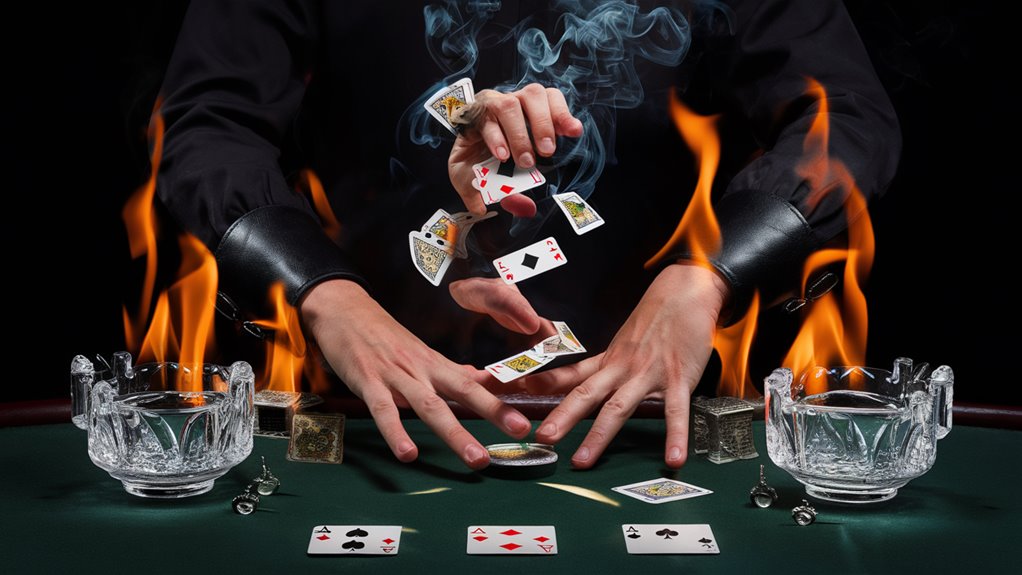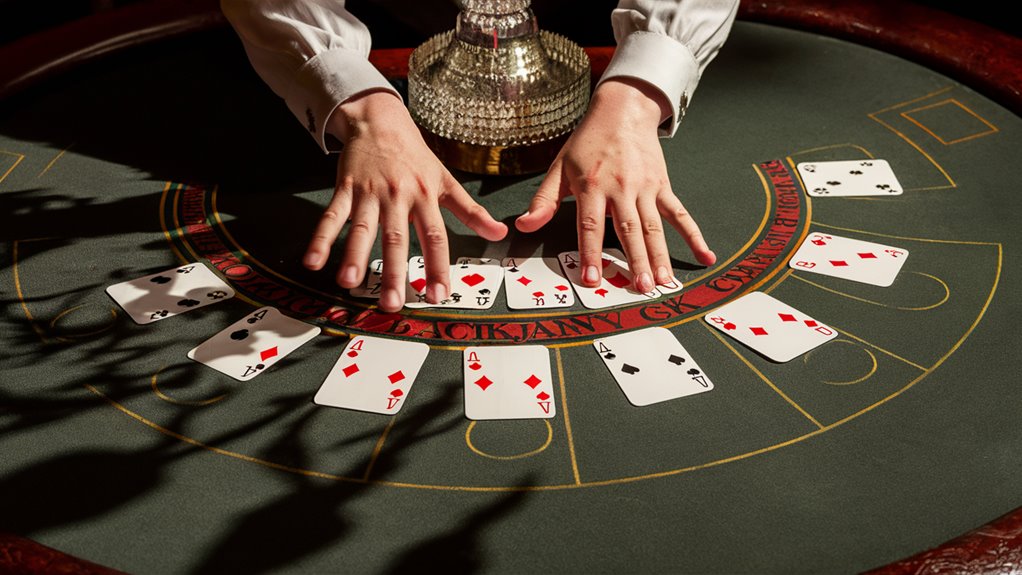
Flickerflame Blackjack: Simple Dealer Moves Study

Know Dealer Moves
Flickerflame blackjack is a deep way to watch small dealer moves when you play. Normal blackjack uses math, but knowing dealer moves might give extra game tips.
Key Points in Dealer Moves
Good blackjack move finding needs you to watch well:
- How hands are held when giving cards
- Ways of using the deck 신뢰할 수 있는 리뷰 보기
- Time gaps between deals
- How cards are shown
Adding Moves into Play
Using move watching in basic blackjack steps helps play by:
- Better timing in split choices
- Strong bets
- Smart plays
- Picking the best table
Playing Better
Pro blackjack kids use many parts:
- Math
- Money management
- Smart table picks
- Good timing
Better Table Smarts
Knowing dealer beats opens chances for:
- Better hand seeing
- Smart split timing
- Better double-down choices
- Smart spot moves
This full way to top blackjack joins normal ideas and deep watching skills, making a smarter game feel.
The Start of Flickerflame Thoughts: A Past Look
Starts in Las Vegas
The start of Flickerflame ideas goes back to the busy card spots in 1950s Las Vegas.
Pro players first wrote down this top new way after seeing small hand moves when splitting cards. These first watchers set the base for a very smart play system.
What Words Mean and Basic Ideas
The name “Flickerflame” came from quick, fire-like hand moves dealers make when unsure about their hidden cards.
This big move started the plan, helped by a lot of old game notes and real talks showing it works.
How It Got Better and Uses Now
By 1962, Flickerflame ways grew a lot with the use of right-on time parts.
Users started looking at tiny time changes in how dealers hit cards, moving from just watching to a full study.
The now way mixes these first ideas with new time tech and smart mind watch signs, making a sharp system that grows from old roots but also uses new tech.
Main Parts of Modern Flickerflame:
- Deep time studies
- Pattern seeing
- Dealer move finding
- Smart card watch ways
The idea’s growth from its Las Vegas start to its smart form now shows the big mark of those first game kids who saw these small but key dealer moves.
Know Dealer Move Patterns in Card Games
Main Move Ideas
Smart dealer watching is key in top card game play.
Dealers show sure body moves when they handle cards, mainly when making big choices.
Three big move groups show these patterns: hand spots, card moves, and time changes.
Looking at Hand Spots
Wrist tips and finger spots are key hints of dealer acts.
Pro looks find that a 15-degree wrist turn often shows good chances, while still hands mean play it safe.
These body signs give good game tips when you read them right.
Card Move Hints
Smart card moves show in clear body tells. Key things to see are:
- How the deck feels
- How cards slide
- How grips change
Smart dealers change how they hold cards based on what the cards are.
Fast slides often mean face cards, while slow moves mean low cards.
Seeing Time Patterns
Tiny time gaps between showing cards make clear rhythm patterns.
These time gaps follow set beats that can be tracked by set watch ways.
Knowing these time patterns helps players see the best times to make smart choices.
Quick Pattern Finding Ways

Setting Basic Finding Ideas
Quick pattern finding needs smart watching steps that go past just looking.
A good mind plan for putting tiny moves in groups lets you read acts in tiny bits of time.
The mind must be set to know these fast hints on its own, like smart matching systems.
Three-Layer Finding System
Basic move setting, change finding, and linking the dots are the main parts of deep pattern finding.
The first part needs you to watch usual rhythms and moves.
By keeping these in mind – like spot moves, flow of moves, and how cards come – watchers can set strong base marks for checks.
Smart Link Ways
Small-change finding matters a lot when you see key pattern changes.
The smart link between seen changes and set situations needs making quick mind paths for fast finding.
With set work using different-speed videos, watchers can make a full move finding list that lets fast choice-making. This deep pattern finding plan makes sure you do your best in quick study needs.
Make Top Quick Answer Skills: A Full Guide
Building Mind Paths with Smart Practice
Quick answer practice needs mind paths to be made with set drills.
This full guide shows true ways to make fast choice skills better with step-by-step skill making.
First Training Ways
Start with fast card drills that show simple spots in 30-second parts.
The first aim is to get the right pattern finding in a 2-second answer time while keeping 95% right.
Then make answer times shorter to 1 second, then 0.5 seconds as you get better.
Deep Pattern Finding
Move study practice adds hard parts to your drills.
Look at recorded bits to see small patterns in moves, times, and rhythm parts.
Using a beat-based practice way helps you get your pattern finding right with usual time beats.
Real-Time Use
The last training part joins basic skills with real-time tryout practice.
Use made-up game software that makes random move parts at growing speeds.
Watch key act marks:
- How fast you react
- How often you’re right
- How well you find patterns
- How on-time you are
Change how hard you train based on clear act facts, working on tiny-time bettering through steady drills and getting better.
Know Usual Dealer Defense Ways
Body Tells and Changes
Pro dealers get small defense moves to keep in control during play.
Seeing these moves is key for smart players who want to play their best.
Defense moves often show in tiny changes in card moves and how dealers stand.
Key Acting Hints
Dealer time changes are main defense ways, including:
- Changed deal speeds during big hands
- Smart waits between deals
- When cards show time changes
- Set stand changes
Smart Defense Moves
Smart dealers use deep defense moves that include:
- Mixing shuffle ways
- Smart chip moves
- Set breathing changes
- Set eye talks during key times
Finding and Knowing Defense
Top knowing of these defense moves needs deep watching of:
- Small body changes (collar touches, straightening clothes)
- Deal rhythm changes
- Table handling changes
- Set talks starting
How It Changes Game Choices
Knowing dealer defense moves helps:
- Fast choice skills
- Card worth finding right
- Counting cards better
- Overall play being best
Kids who see and use these defense moves do much better in staying sharp and making top plays.
Rules and Fair Play Guides for Watching Casino Games
Know Casino Rules and Player Rights
Casino watching rules are in big rule sets that change by place.
In big game spots like Nevada, just watching without help stays okay. But where watching stops and playing too smart starts needs careful walking.
Casino Power and Player Limits
Casinos can stop serving any player they think has an unfair edge.
Watching dealer moves might get you kicked out or put on no-go lists. The line between just watching and using the system is key to follow.
Following Rules and Playing Fair
Game rules and house ways set clear lines for how to act. How to Set Realistic Gambling Goals and Achieve Them
While easy pattern finding is okay, using deep tracking gear or planned watching breaks core game ideas.
Pro dealers should be treated right, making any use of their unplanned moves not just bad by rules, but also not nice, no matter if it’s allowed.
Main Law Points
- Local game laws set what’s okay
- Casino rules make house rules and limits
- Watching limits change by place
- Casinos can kick players out
- Fair play rules keep dealer respect


